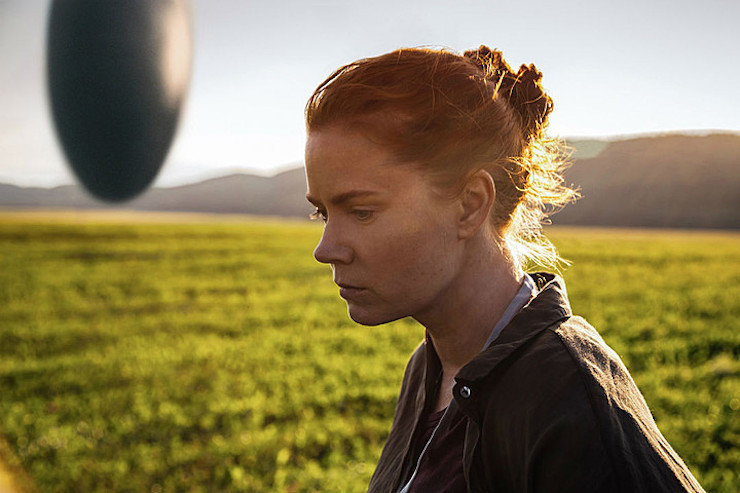USA Today has released the first images from Arrival, Denis Villeneuve’s forthcoming adaptation of Ted Chiang’s 1998 novella Story of Your Life and one of Paramount’s most anticipated films this year. We get our first look at Amy Adams and Jeremy Renner as a linguist and a physicist whose specialties are utilized when aliens land all over Earth and humans scramble to find a way to communicate with their extraterrestrial visitors, who possess a bizarre verbal and visual language.
This film has been in the works since 2012 but recently gained traction after Eric Heisserer (The Thing remake, Lights Out) revised the script and Adams and Renner signed on. Renner, who plays physicist Ian Donnelly, told USA Today that the movie’s tone is “if you blended a [Stanley] Kubrick and a [Steven] Spielberg movie,” and that the end result comes out closer to Contact or Close Encounters of the Third Kind than “a big Michael Bay alien movie”—which makes sense, since the entire story is about first contact. Summoned by the military, linguist Louise Banks (Adams) must learn the aliens’ two languages: the verbal Heptapod A, with its free word order, and the much more complex and visual Heptapod B.
Reeling from personal turmoil, Louise struggles to relate to these otherworldly creatures. Adams praised the fact that “[t]his isn’t a graphic-novel universe or creating a new universe. This happens in our world today, as it exists. Not having to transport myself to a universe where superheroes exist, which is also fun, really helped me ground the character and the experience.” Speaking of worldbuilding, she said, “Denis and the team have done a great job with the visuals and getting to something that looks familiar and not completely abstract.”
That’s a high bar, considering how the Louise of Story of Your Life describes Heptapod B, made up of semagrams (or ideograms that mark semantic categories of words):
A “sentence” seemed to be whatever number of semagrams a heptapod wanted to join together; the only difference between a sentence and a paragraph, or a page, was size.
When a Heptapod B sentence grew fairly sizable, its visual impact was remarkable. If I wasn’t trying to decipher it, the writing looked like fanciful praying mantids drawn in a cursive style, all clinging to each other to form an Escheresque lattice, each slightly different in its stance. And the biggest sentences had an effect similar to that of psychedelic posters: sometimes eye-watering, sometimes hypnotic.
[…]
The heptapods didn’t write a sentence one semagram at a time; they built it out of strokes irrespective of individual semagrams. I had seen a similarly high degree of integration before in calligraphic designs, particularly those employing the Arabic alphabet. But those designs had required careful planning by expert calligraphers. No one could lay out such an intricate design at the speed needed for holding a conversation. At least, no human could.
While Louise is struggling to comprehend a language that’s alien in more ways than one, the rest of Earth is also having trouble communicating. Renner explained to USA Today how different countries share information about their respective heptapod visitors while catering to their own individual fears and agendas: “You see the divide in the unity with people across the world and what that does as well.”

In addition to his Spielberg and Kubrick allusions, Renner said of the movie, “If you’re a parent, it’s going to wreck you. It’s big and there are thriller elements and tension, but it’s going to lean much more into a thinking person’s film.”
Electric Literature recently interviewed Chiang about the adaptation; the conversation, no surprise, turned to language and the differences between the written word and film:
[Meghan] McCarron: “Story of Your Life” concerns a linguist’s personal transformation in the process of learning an alien language, and now the story is being made into a movie. What has it been like seeing the story transformed into the alien language of film?
Chiang: That’s a good way to put it! Film really is an alien language. Or at least it’s a language that I have some fluency in as a listener, but one that I don’t speak at all. I’ve always been aware of this at some level, but I was definitely reminded of it when I was first approached about the adaptation of “Story of Your Life,” because it’s not a story that I would have ever pitched to be made into a film. And this ties in with what we were saying about how deeply the written word is embedded in our consciousnesses. Because when a story idea crystallizes in my mind, what I’m thinking about are sentences. I assume that if I were a screenwriter, I’d be picturing scenes, and it makes me wonder about how deep are the differences between these two modes of storytelling.
The process of adapting a book for film is also mysterious to me. In particular I’m thinking of the differences between the movie L.A. Confidential and the James Ellroy novel it was based on. I read the novel after seeing the movie, and was really surprised by it. The plot of the movie is fairly complicated, but it’s nothing compared to the vast, sprawling conspiracy in the novel. If I had read the novel first, I would have said it was impossible to adapt into a movie. But what the screenwriters did was take the protagonists of the novel and construct a completely new plot in which those characters could play the same basic roles. The resulting movie is faithful to the spirit of the novel even though it’s radically unfaithful to the text. That’s an approach that would never have occurred to me; I think I’d be too reverent of the original to adapt anything to film.
And then there’s the whole industrial-production side of movies. Based on the tiny bit of the process that I’ve become aware of, making a movie seems like trying to plan the invasion of Normandy and creating a piece of art at the same time. It’s kind of a miracle that any movie turns out well, given the logistical nightmare that’s required to make one. The process for the “Story of Your Life” adaptation has been relatively smooth, I think; not fast — it’s been five years since I was first contacted — but there haven’t been too many cooks involved. It seems like the project has managed to avoid the typical Hollywood disasters you hear about. I’m looking forward to seeing it.
Arrival is now in theaters; here’s our review. And Barnes & Noble Sci-Fi recommends five other Ted Chiang stories (also from the collection Stories of Your Life and Others) that would make equally excellent adaptations.










